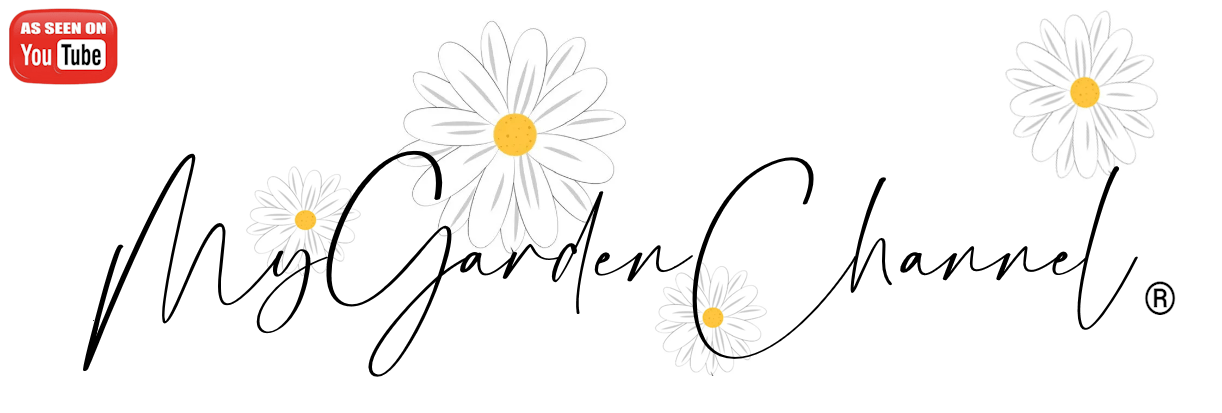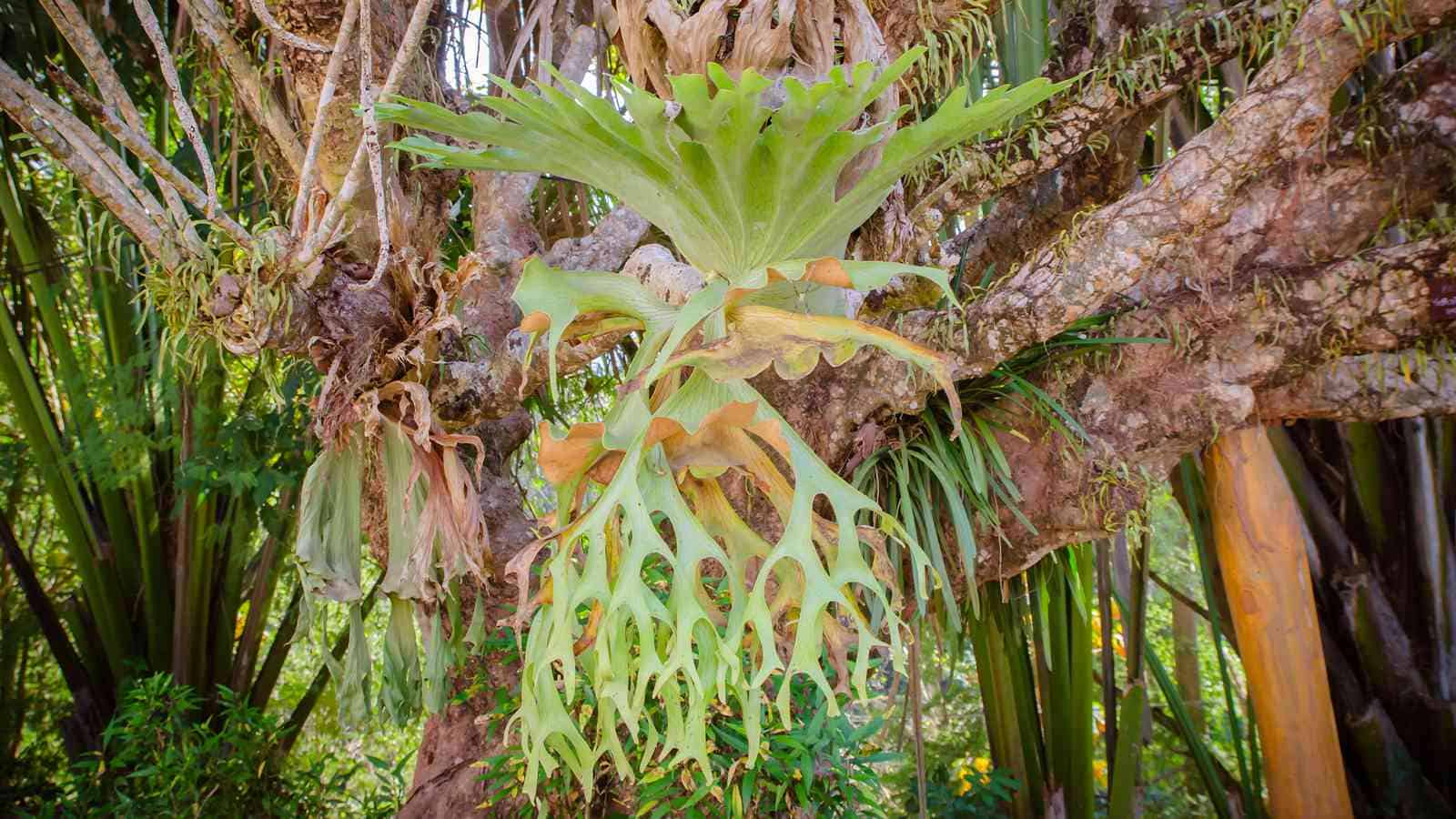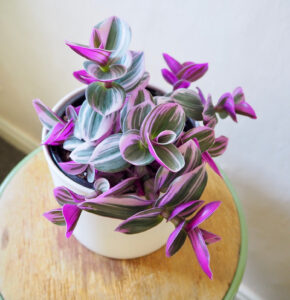Staghorn Fern
STAGHORN FERN: All You Need To Know About Growing, Care, Propagation and Hanging Them.
Introduction:
Did you know that staghorn ferns can thrive for decades with the right care, transforming your space into a lush oasis? There are also 18 different varieties of Platycerium, or staghorn fern.
Staghorn fern plants, with their unique and captivating appearance, have become increasingly popular among plant enthusiasts. Known for their antler-like fronds and ability to grow both indoors and outdoors, these plants bring a touch of natural elegance to any space.
In this blog post, we will also delve into the fascinating world of staghorn plants and explore how to properly care for them to ensure their health and vitality.
Staghorn Fern Video Instructions:
In this video, you’ll learn how to care for staghorn ferns, unique plants that not only beautify your environment but are also surprisingly easy to maintain.
Staghorn Fern Care
Understanding Staghorn Fern Plants
Staghorn plants, scientifically known as Platycerium, belong to the fern family. They are epiphytic plants, meaning they naturally grow on other plants or trees without causing any harm.
Their distinctive fronds resemble the antlers of a majestic stag, hence their name. With their large shield-shaped fronds, known as basal fronds, and fertile fronds that produce spores for reproduction, staghorn plants have a truly unique and eye-catching appearance.
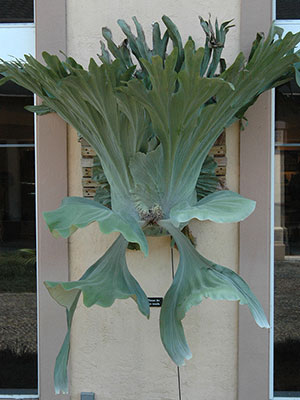
Selecting the Right Growing Environment
Furthermore, staghorn plants require a suitable growing environment that mimics their natural habitat. Also, they prefer bright, indirect light, making them ideal for spaces with filtered sunlight or partial shade. When selecting a location, consider the species size and growth habit, as some varieties can grow quite large.
Additionally, ensure proper air circulation to prevent excessive moisture accumulation, which can lead to fungal diseases.
Watering and Humidity Requirements
Proper watering is crucial for the health of staghorn plants. They prefer consistent moisture, but not waterlogged conditions. When watering, soak the plant thoroughly and allow excess water to drain away. It is important to note that staghorn plants are not drought-tolerant and may wilt if not watered adequately. In addition to watering, maintaining a humid environment is essential. Mist the fronds regularly or use a humidifier to prevent them from drying out.
Feeding and Fertilization
To support optimal growth, staghorn plants benefit from regular feeding. Use a balanced, water-soluble fertilizer diluted to half strength, and apply it every two to four weeks during the growing season. Be sure to avoid direct contact with the fronds when fertilizing, as it can cause damage.
Additionally, consider using organic fertilizers or natural alternatives to minimize the risk of chemical burn.
Staghorn Fern Mounting
Potting and Mounting Options
Staghorn plants can be grown in pots or mounted on various surfaces, such as wooden boards, cork, or tree branches. When potting, choose a well-draining medium, such as a mixture of orchid bark, sphagnum moss, and perlite. Mounting staghorn plants on a substrate allows them to grow more naturally as well as resembling their epiphytic habitat.
Secure the plant firmly using natural twine or wire but ensuring it has enough stability to grow and thrive.
Staghorn Fern Varieties
18 Species of Platycerium (Staghorn Fern)
Staghorn ferns (genus Platycerium) are a unique group of epiphytic ferns native to tropical and subtropical regions. They are also named for their fronds that resemble the antlers of a stag.
There are 18 species in the genus, also with several hybrids and cultivars. Let’s take a look at identifying them. Here are the main varieties:
Staghorn Ferns
1. Platycerium bifurcatum

Description: The Platycerium bifurcatum, commonly known as the staghorn fern, is a striking epiphytic plant admired for its antler-like fronds and unique growth habit. Native to tropical and subtropical regions, this low-maintenance fern thrives when mounted on trees, wooden boards, or hanging baskets, mimicking its natural habitat.
The Platycerium bifurcatum features two types of fronds—shield fronds, which protect the root system and store nutrients, and fertile fronds, which resemble stag antlers and give the plant its name. This staghorn fern prefers bright, indirect light, high humidity, and well-draining conditions, making it an excellent choice for both indoor and outdoor spaces.
With proper care, the Platycerium bifurcatum can grow into a magnificent, sculptural centerpiece, adding a tropical and exotic touch to any plant collection.One of the most common species grown as a houseplant. It is known for its large, bifurcated fronds that look like deer antlers. It is hardy and relatively easy to care for but tolerating a wide range of humidity levels.
2. Platycerium superbum

Description:
The Platycerium superbum, a stunning variety of staghorn fern, is an epiphytic plant known for its massive, shield-like fronds and dramatic, cascading growth. Native to Australia and Southeast Asia, this majestic fern thrives when mounted on trees or wooden boards, mimicking its natural habitat.
Unlike other staghorn ferns, the Platycerium superbum produces a single, large, nest-like cluster of shield fronds that store moisture and nutrients, supporting the growth of its elegant, fertile fronds.
This low-maintenance fern prefers bright, indirect light, high humidity, and good air circulation, making it an excellent choice for tropical gardens or indoor displays. With proper care, the Platycerium superbum can grow into a breathtaking living sculpture, adding a bold, exotic statement to any space.
This Australian species has large giant but shield-like basal fronds and bifurcated fertile fronds. However, it tends to grow as a single rosette and is quite impressive in size and often growing to several feet wide.
3. Platycerium grande

Description:
The Platycerium grande, a magnificent species of staghorn fern, is known for its impressive, elongated fronds that create a striking, sculptural display. Native to the Philippines, this epiphytic fern thrives when mounted on trees, wooden boards, or hanging structures, mimicking its natural growth in tropical rainforests.
Unlike other staghorn ferns, the Platycerium grande features large, lobed fertile fronds that cascade gracefully, resembling a waterfall of greenery, while its shield fronds help absorb moisture and nutrients.
This rare and highly sought-after fern prefers bright, indirect light, high humidity, and well-draining conditions, making it ideal for tropical gardens and indoor collections. With proper care, the Platycerium grande becomes a living masterpiece, adding a bold and exotic presence to any space.
Similar to P. superbum, this species from the Philippines has large, giant, upright sterile fronds and long, arching fertile fronds. It’s notable for its large size, making it a popular species for display. Also commonly named “Giant” staghorn fern.
4. Platycerium veitchii

Platycerium veitchii, or Silver Staghorn Fern, is a drought-tolerant epiphytic fern native to Australia. It also features fuzzy, silvery fronds that reflect sunlight and reduce water loss.
The plant has two types of fronds: shield fronds, which protect the roots, and long, antler-like fertile fronds. It thrives in bright, indirect light with occasional direct sun, requires moderate watering, and prefers mounting on wood or hanging baskets. This fern adapts well to dry conditions and benefits from good airflow.
With proper care, including occasional fertilization and pest control, Platycerium veitchii develops striking, cascading fronds, while making it a unique ornamental plant.
Native to Australia, this fern is drought-tolerant and has a silvery coating on its fronds, giving it a distinctive appearance. Likewise, it is more compact than some of the larger species, making it suitable for smaller spaces.
5. Platycerium hillii

Platycerium hillii, a stunning staghorn fern species, is known for its broad, wavy fertile fronds and rounded shield fronds. Native to tropical regions, it thrives in warm, humid environments with bright, indirect light.
This epiphytic fern grows best when mounted on wood or placed in hanging baskets with excellent airflow. Water moderately, while allowing the plant to dry between waterings to prevent root rot.
Regular misting supports humidity needs. Fertilize monthly during the growing season for optimal growth. With its sculptural, antler-like fronds and resilience, Platycerium hillii is a striking addition to indoor and outdoor plant collections.
A smaller species from Australia, P. hillii has rounded, shield-like basal fronds and bifurcated fertile fronds. It’s a popular choice for indoor cultivation due to its manageable size.
6. Platycerium elephantotis

Platycerium elephantotis, also known as the Elephant Ear Staghorn Fern, is a unique epiphytic fern distinguished by its large, shield-like fronds with a wrinkled texture. Unlike other staghorn ferns, it lacks deeply lobed fertile fronds, giving it a bold, tropical appearance.
Native to Africa, it thrives in warm, humid environments with bright, indirect light. Mount it on wood or place it in a well-draining basket, ensuring good airflow. Water moderately, also allowing the roots to dry between waterings.
Regular misting and occasional fertilization promote healthy growth. Platycerium elephantotis adds a dramatic, exotic touch to any plant collection.
Named for its large, elephant-ear-like basal fronds, this species is native to Africa. Its fertile fronds are smaller and less dramatically bifurcated compared to other species. Furthermore, Elephant staghorn fern.
7. Platycerium ridleyi

Platycerium ridleyi, a rare and exotic staghorn fern, is known for its unique, deeply lobed fertile fronds and compact shield fronds with intricate veining. Native to Southeast Asia, it thrives in warm, humid environments with bright, indirect light. This epiphytic fern grows best when mounted on wood or placed in a well-ventilated basket.
Water consistently but allow slight drying between waterings to prevent rot. High humidity and good airflow are essential for healthy growth.
Fertilize monthly during the growing season. With its striking foliage and distinct growth habit, Platycerium ridleyi is a prized addition to any fern collection.
Native to Malaysia, this species is quite rare and unique. It has deeply lobed, circular basal fronds and relatively short fertile fronds. However, it’s one of the more difficult species to cultivate in home environments.
8. Platycerium andinum

Platycerium andinum is a rare staghorn fern native to South America, distinguished by its elongated, deeply lobed fertile fronds and rounded shield fronds. Unlike other Platycerium species, it thrives in drier conditions, making it more tolerant of lower humidity.
It prefers bright, indirect light and should be mounted on wood or placed in a well-draining basket for proper airflow. Water moderately, allowing the roots to dry between waterings to prevent rot.
Occasional fertilization supports healthy growth. With its unique appearance and adaptability, Platycerium andinum is a fascinating addition to any staghorn fern collection, also offering striking foliage and resilience.
The only species native to South America (Peru and Bolivia), it is smaller than many other species and has a somewhat unusual appearance with its narrow, elongated fertile fronds.
9. Platycerium stemaria

Platycerium stemaria, a striking staghorn fern species, is native to Africa and known for its broad, deeply lobed fertile fronds that resemble a forked shape.
Its shield fronds are rounded and often develop a wavy texture as they mature. This epiphytic fern thrives in warm, humid environments with bright, indirect light.
Best grown mounted on wood or in a hanging basket, it requires good airflow to prevent rot. Water moderately, also allowing the roots to dry between waterings.
Monthly fertilization supports healthy growth. With its dramatic fronds and resilience, Platycerium stemaria is a unique and beautiful addition to any fern collection.
Found in Madagascar and parts of Africa, this species has very distinct, narrow fronds that are deeply bifurcated, giving them a striking, but spidery appearance.
10. Platycerium coronarium

Platycerium coronarium, a majestic staghorn fern native to Southeast Asia, is known for its long, arching fertile fronds that resemble cascading antlers. Its shield fronds grow large and form a nest-like structure, while aiding in nutrient absorption.
This epiphytic fern thrives in warm, humid environments with bright, indirect light. It should be mounted on wood or placed in a well-ventilated basket for optimal growth.
Water consistently but allow slight drying between waterings to prevent rot. Regular misting and monthly fertilization support healthy development. Platycerium coronarium’s dramatic, also flowing fronds make it a stunning and prized addition to any plant collection.
Native to Southeast Asia, this species has large, pendulous fertile fronds that can grow very long. It is known for its dramatic appearance and is often cultivated in tropical gardens or greenhouses.
11. Staghorn Fern Platycerium quadridichotomum
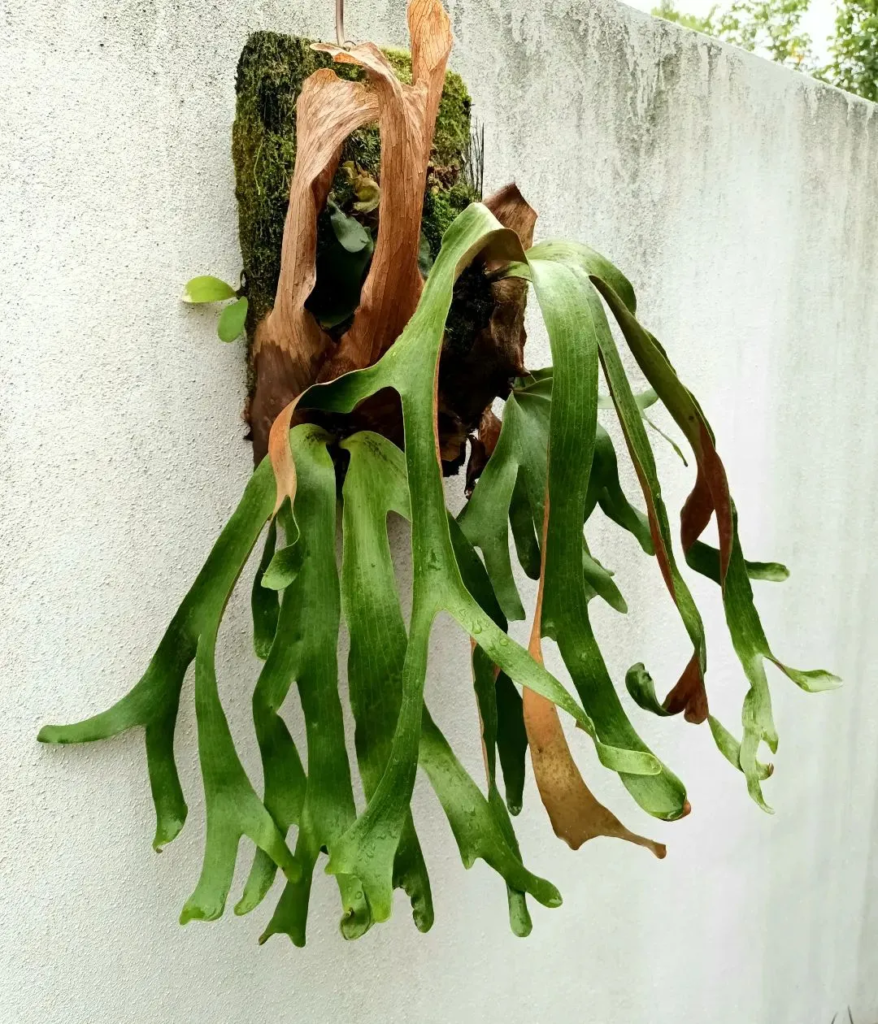
Platycerium quadridichotomum is a rare and distinctive staghorn fern known for its deeply lobed, arching fertile fronds and rounded shield fronds. Native to tropical regions, it thrives in warm, humid environments with bright, indirect light.
This epiphytic fern grows best when mounted on wood or placed in a well-draining basket, ensuring proper airflow. Water moderately, also allowing the roots to dry between waterings to prevent rot.
Regular misting and occasional fertilization promote healthy growth. With its unique frond structure and striking appearance, Platycerium quadridichotomum is a prized addition to any staghorn fern collection, while bringing an exotic and sculptural touch.
Native to the Solomon Islands, this rare species has fertile fronds that bifurcate multiple times, also giving them a dense, branching appearance.
12. Platycerium wandae

Platycerium wandae, one of the largest staghorn fern species, is native to Papua New Guinea and prized for its massive, arching fertile fronds that can reach impressive lengths.
Its broad shield fronds form a protective, nest-like structure, aiding in moisture and nutrient retention. This epiphytic fern thrives in warm, humid environments with bright, indirect light.
Best grown mounted on wood or in a well-ventilated basket, it requires good airflow to prevent rot. Water moderately, allowing the roots to dry between waterings. Regular fertilization encourages vigorous growth.
Platycerium wandae is a striking, statement-making staghorn fern perfect for large plant displays.
One of the largest species, P. wandae can grow to enormous sizes with large, wide basal fronds and long, draping fertile fronds. It is native to New Guinea and is often grown in large spaces due to its size.
13. Platycerium alcicorne

Platycerium alcicorne, a stunning staghorn fern native to Madagascar and Africa, is known for its deeply lobed, antler-like fertile fronds and rounded shield fronds.
This epiphytic fern thrives in warm, humid environments with bright, indirect light. It grows best when mounted on wood or placed in a well-draining hanging basket, ensuring proper airflow. Water moderately, allowing the roots to dry between waterings to prevent rot. Regular misting and monthly fertilization promote healthy growth.
With its striking frond structure and resilience, Platycerium alcicorne is a unique and eye-catching staghorn fern, making it a prized addition to any plant collection.
Often confused with P. bifurcatum, this African species has similarly bifurcated fronds, but its overall form is more compact, and its fronds are often more deeply cut.
14. Staghorn Fern Platycerium wallichii

Platycerium wallichii, a unique staghorn fern native to Southeast Asia, is known for its elongated, pendulous fertile fronds and rounded shield fronds with a textured appearance.
This epiphytic fern thrives in warm, humid environments with bright, indirect light. It grows best when mounted on wood or placed in a well-ventilated hanging basket to ensure proper airflow.
Water moderately, allowing the roots to dry slightly between waterings to prevent rot. Regular misting and monthly fertilization support healthy growth. With its cascading, elegant fronds, Platycerium wallichii is a striking and exotic staghorn fern, making it a prized addition to any collection.
Native to Southeast Asia, this species has wide, flattened basal fronds and long, also trailing fertile fronds. It’s less common in cultivation and can be more difficult to grow.
15. Platycerium madagascariense

Platycerium madagascariense, a rare and striking staghorn fern native to Madagascar, is known for its unique, deeply veined shield fronds that grow tightly against its mounting surface.
Unlike other staghorn ferns, its shield fronds remain green and do not brown with age. Its fertile fronds are upright and lobed, creating a sculptural appearance. This epiphytic fern thrives in warm, humid environments with bright, indirect light. It grows best when mounted on wood, requiring good airflow and moderate watering.
Regular misting and fertilization encourage healthy growth. Platycerium madagascariense is a prized collector’s staghorn fern, valued for its distinct foliage.
Found in Madagascar, this species is unique due to its thick, leathery fronds and its smaller size compared to other species. However, it is well-suited to high-humidity environments.
16. Platycerium ellisii

Platycerium ellisii, a rare and elegant staghorn fern native to Madagascar, is known for its slender, elongated fertile fronds and compact, also rounded shield fronds.
This epiphytic fern thrives in warm, humid environments with bright, while indirect light. It also prefers to be mounted on wood or placed in a well-ventilated hanging basket to ensure proper airflow.
Water moderately, allowing the roots to dry slightly between waterings to prevent rot. Regular misting and occasional fertilization support healthy growth. With its graceful frond structure and adaptability, Platycerium ellisii is a unique and highly desirable staghorn fern for collectors and plant enthusiasts.
Another species from Madagascar, P. ellisii has thin, upright sterile fronds and deeply bifurcated fertile fronds. It is less common in cultivation and requires specific growing conditions.
17. Platycerium holttumii

Platycerium holttumii, a magnificent staghorn fern native to Southeast Asia, is known for its large, deeply lobed fertile fronds and broad, overlapping shield fronds.
This epiphytic fern thrives in warm, humid environments with bright, indirect light and good airflow. It is best grown mounted on wood or in a well-ventilated hanging basket. Water moderately, allowing the roots to dry slightly between waterings to prevent rot. Regular misting and monthly fertilization promote vigorous growth.
With its impressive size and striking frond structure, Platycerium holttumii is a prized staghorn fern, making a dramatic and beautiful addition to any plant collection.
This Southeast Asian species has relatively short and wide fertile fronds, and its shield fronds are more upright. While it is rare and not commonly found in cultivation.
18. Platycerium willinckii
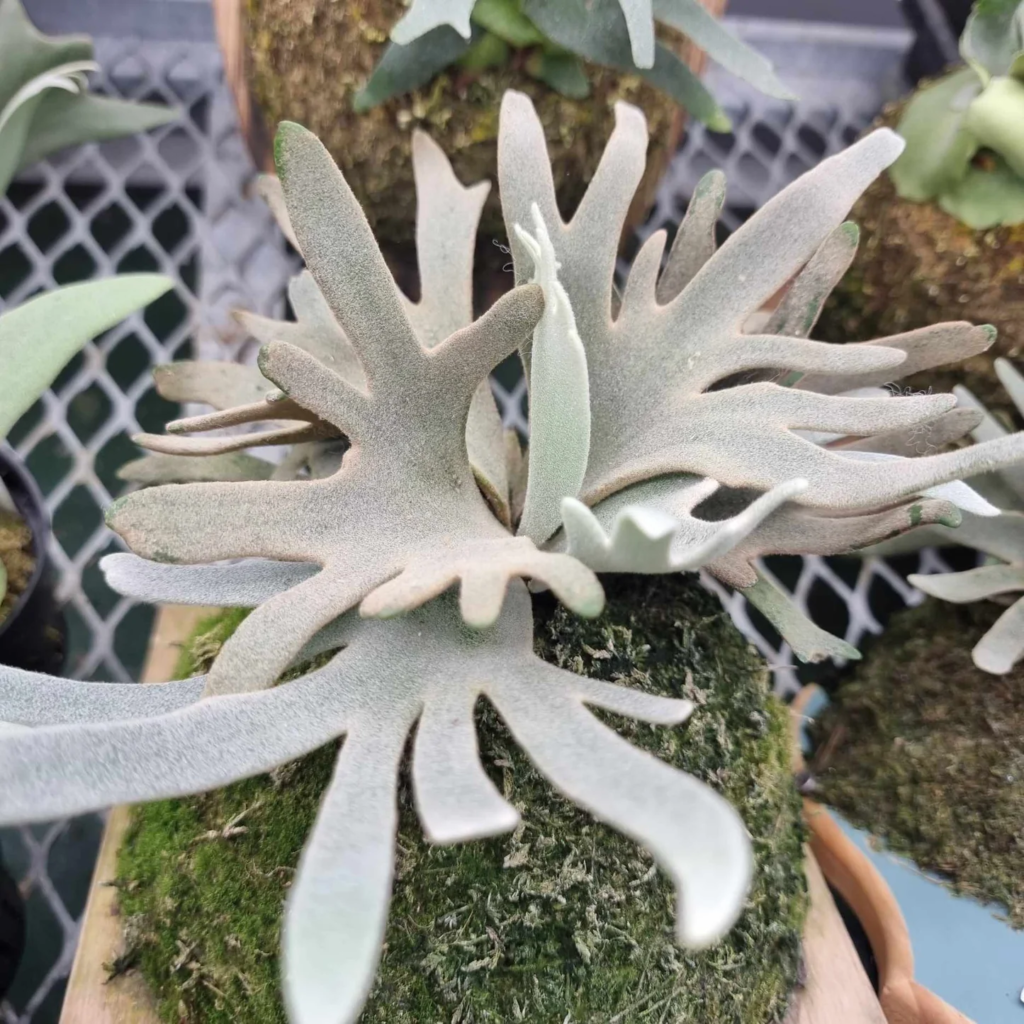
Platycerium willinckii, a distinctive staghorn fern native to Indonesia, is admired for its long, narrow, deeply lobed fertile fronds that cascade elegantly. Its shield fronds are compact and wavy, while forming a protective base that aids in moisture and nutrient absorption.
This epiphytic fern thrives in warm, humid environments with bright, indirect light and good airflow. Best grown mounted on wood or in a hanging basket, it requires moderate watering, also allowing the roots to dry between waterings to prevent rot. Regular misting and fertilization encourage healthy growth.
Platycerium willinckii’s unique frond structure makes it a stunning addition to any fern collection.
A small species native to Australia and also this fern has narrow, finely divided fronds and is more delicate in appearance. It is less commonly grown but suitable for indoor cultivation in small spaces.
Each species of staghorn fern has its own unique aesthetic and care requirements, but all share the characteristic antler-shaped fronds and epiphytic growing habit.
Where To Buy Your Own Staghorn Fern?
MyGardenChannel also has an online Shop! Click the image to check out Staghorn Fern Prices.


Diseases and Care
Staghorn Fern Disease: Description and Care
Staghorn ferns (Platycerium spp.) are unique epiphytic plants known for their antler-like fronds. While generally resilient, they can suffer from various diseases caused by fungal, bacterial, or environmental factors. Common staghorn fern diseases include:
- Rhizoctonia Blight (Black Spot Disease): Caused by fungi, it appears as black or brown spots on fronds, often spreading in humid conditions.
- Bacterial Soft Rot: Leads to mushy, blackened areas due to excessive moisture and poor airflow.
- Leaf Spot Disease: Small brown or yellow lesions caused by fungal infections, often worsened by high humidity.
- Root Rot: Results from overwatering, leading to a decaying base and weakening the plant.
Staghorn ferns (Platycerium spp.) are generally resilient, but they can be susceptible to certain diseases. Below are descriptions and visual references for common staghorn fern diseases:
1. Rhizoctonia Blight (Black Spot Disease):
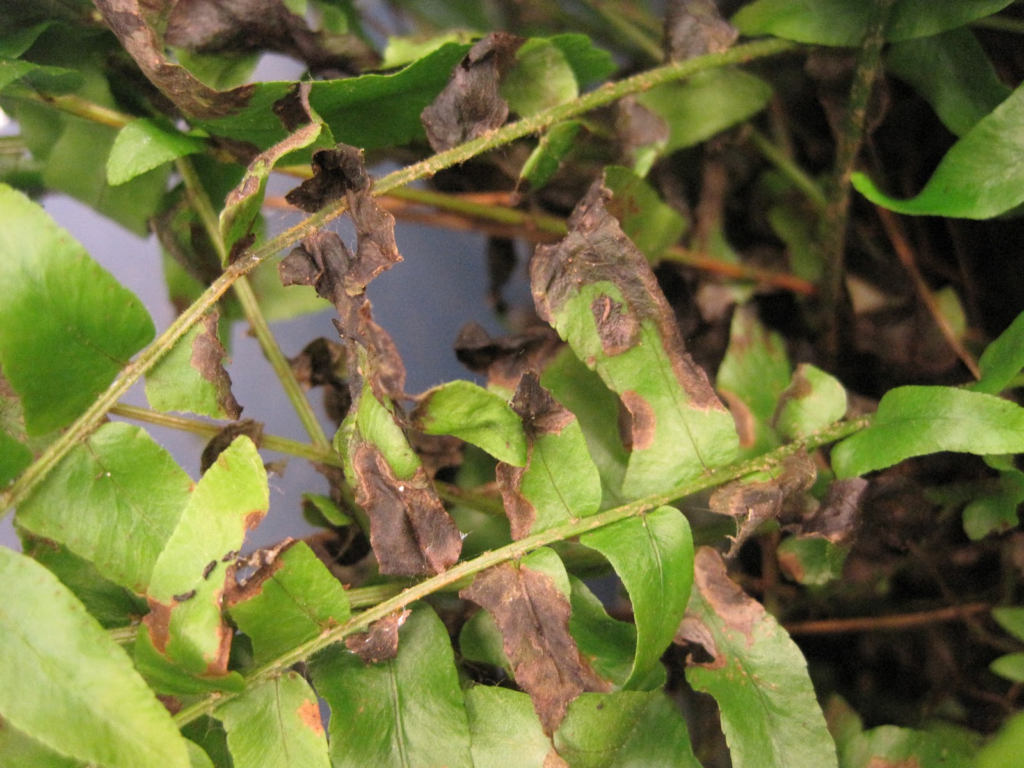
- Description: This fungal infection manifests as black or brown spots on the fronds, often starting in the interior and spreading outward. Also, high humidity and overwatering can exacerbate this condition.
- Visual Reference: Rhizoctonia Blight on Boston Fern
2. Bacterial Soft Rot:

- Description: Caused by bacteria, this disease leads to mushy, water-soaked, and blackened areas on the plant, often accompanied by a foul odor. Also, it typically results from excessive moisture and poor air circulation.
- Visual Reference: Bacterial Soft Rot
3. Leaf Spot Disease:

- Description: Characterized by small brown or black lesions on the fronds, this fungal disease can cause the affected areas to die and drop out, while giving the leaves a tattered appearance.
- Visual Reference: Leaf Spot on Staghorn Fern
4. Root Rot:

- Description: Resulting from overwatering or poorly draining media, root rot causes the roots to become brown or black and mushy. Also, affected plants may exhibit wilting, yellowing, or stunted growth.
- Visual Reference: Root Rot in Staghorn Fern
Care and Treatment:
How To Save A Dying Staghorn
To prevent and manage diseases, follow these care tips:
- Provide Proper Air Circulation: Ensure good air circulation around the plant to reduce excess moisture and fungal growth.
- Control Humidity Levels: Maintain moderate humidity but avoid excessive moisture that can encourage bacterial and fungal infections.
- Avoid Overwatering: Water only when the growing medium is dry, and never let water pool at the base of the plant. Also, use a well-draining mounting surface.
- Remove Affected Areas: Prune and discard diseased fronds to prevent the spread of infection. Also, use sterilized scissors or shears.
- Use Fungicides or Bactericides: Apply a copper-based fungicide or neem oil for fungal infections and a mild hydrogen peroxide solution for bacterial issues.
- Improve Airflow and Light: Place the plant in bright, indirect light with good airflow to prevent mold and mildew.
- Avoid Over-Fertilization: Excess nitrogen can promote soft, weak growth that is more susceptible to disease. Use a balanced, diluted fertilizer occasionally.
For more images and detailed information on these diseases, you may also refer to the provided links.
By maintaining optimal growing conditions and promptly addressing any signs of disease, your staghorn fern can thrive for many years.
